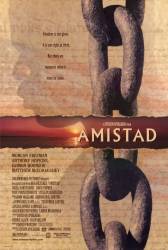Factual error: While the movie depicts and later mentions that almost the entirety of the original crew of the Amistad was killed, this is simply untrue. In fact, only two people were killed; the cook, who was bludgeoned to death in his sleep, and the captain. Two crew members escaped using a canoe, and the cabin boy flat out refused to participate. (00:03:00)
Factual error: The Portuguese slave ship Tecora was one of the most notorious of the illegal slave ships, but no slaves were thrown overboard in mid-ocean as shown in the film - at least on the trip in question. The Portuguese were pros at the slave trade and had plenty of food on board to feed their "cargo" between Sierra Leone and Cuba. The only time a slave would be thrown overboard in mid-ocean was if his/her health posed a serious risk to the crew and "cargo". (Slaves were too valuable to just throw away for the price of their food.) Historically, though, there were instances where whole cargoes of slaves were tossed overboard. The British Royal Navy zealously patrolled the waters off West Africa to try to shut down the slave trade. If a British ship was sighted, the slavers sometimes tossed slaves overboard to destroy the evidence and prevent the seizure of the ship.
Factual error: Cinque is shown in the first scene of the film ripping a nail (to pick his shackles) from the lower deck of Amistad with his bare and bloody fingers during a storm. In fact, Cinque was topside one day, and simply stooped down to pick up a piece of metal he saw to use as a pick. (Not quite as dramatic, but true.)
Factual error: The scene where the defense team walks on the docks, counting out loud in Mende, in the hope of discovering an interpreter, actually happened - but it was professor Gibbs who did this himself, not Roger Baldwin.
Factual error: Cinque never met John Quincy Adams at his home and never had a discussion about African violets. African violets are native to East Africa, not Sierra Leone in the west, and were only known to the Western world since the 1890s. Cinque probably never saw an African violet in his entire life, and no chance Adams could have one.
Factual error: Roger Baldwin was not a young, inexperienced "ambulance-chaser-type" lawyer. He was about 50 years old and very highly respected. A few years after the Amistad case, Baldwin was elected governor of the State of Connecticut.
Factual error: No presidential candidate campaigned in person until William Jennings Bryan was nominated the Democratic candidate in 1896. Before Bryan, it was the practice that candidates campaign only in their hometown (candidates are to "stand" for office, not "run" for office) while their supporters campaign for them nation-wide.
Factual error: Until the U.S. Supreme Court's ruling, Cinque spent every day of his life in America locked up. He was not present for the Supreme Court's oral argument.
Factual error: At the end of the first trial when the judge said that the Africans are free, he also ordered the immediate arrest of Luis and Montez. According to historical records, they were not even in the country, much less present at the court proceedings. In fact, the Africans had already had them arrested on charges of assault and kidnap. They both paid bail and went back to Cuba.
Factual error: The Royal Navy has never used the rank of ensign, and even if it had it is highly unlikely that a freed slave would have been granted the rank.
Factual error: The Bible Yamba is seen reading in court is the Gustave Dore Illustrated Bible. However, this was first published in 1865, 25 years after the completion of the Amistad case.






Chosen answer: It's likely that the scene was set in the morning, meaning they would be going east.
Greg Dwyer